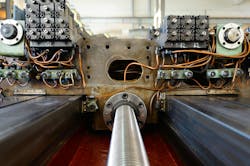How to lessen backlash in ball screw application or replace with another option
July 15, 2024
4 min read
A Control Design reader writes: We generally use ball screws for our motion applications because the conveyance systems we build require precision and speed. What other options are available for reducing backlash? Is there a formula for determining backlash based on load capacity?
Answers
Upgrading servo motor couplings or electric motors
Ball screws continue to be a popular choice for motion applications. However, backlash has always been a concern, even if vendors have continued to improve the offerings. Some even sell “backlash-free” options, but, in practice, no one has eliminated it entirely. And in general, the more power required, the more backlash in the system.
Why? Because it partly depends on the components, and it partly depends on the implementation. If any one piece isn’t entirely tightened down, if there’s any give in the frame, then even the best equation won’t be accurate.
We do provide a spec sheet in our documentation that shows maximum backlash. For example, if you’re using a ball screw with 6 kiloNewtons of force, you can check how much backlash may be present when the screw nut mechanism is fully extended. But solving the challenge of backlash really comes down to component selection. Two great places to start are upgrading your servo motors to options with better couplings or trading the ball screw entirely for a high-speed, high-force electric cylinder.
Many servo motors feature a keyed shaft, so the ball screw unit has a coupling that fits that. However, the necessary tolerances to ensure the coupling will fit on the shaft can lead to wear over time. As the motor rotates one way and the other, the key and keyed slot in the coupling strike each other repeatedly, and that tolerance, which was so minimal at first, grows wider and wider. This introduces greater backlash into the system.
With keyless coupling units, you can attach the ball screw by clamping it to the shaft. That reduces backlash from the outset. More importantly, it removes the risk of backlash multiplying in production. Moving away from keyed coupling is a solid place to start, especially if you don’t have the flexibility to redesign the mechanical system in your current machine.
If you do have just a little bit of leeway, there’s an even better option for these types of applications. Substituting ball screws for electric cylinders offers an extremely high-performance and energy-saving option with no backlash. This servo-electric actuation is an ideal replacement for applications where ball screws don’t offer enough speed, accuracy or force. They’re also ideal when updating pneumatic or hydraulic systems, which are often unnecessarily large, messy and expensive due to energy consumption.
An electric cylinder experiences essentially zero backlash in the system as it retracts to position zero, even at its highest rating. Let’s stick with 6 kiloNewtons in this example. The unit isn't exposed to any distortions, bending or vibrations. When the cylinder is forced into the fully retracted position, any potential backlash is transformed into thermal expansion, and the unit doesn’t generate enough heat to affect the steel actuator or impact repeatability.
That same electric cylinder, when fully extended at 6 kiloNewtons, can minimize backlash via a guide rail that helps absorb some of that load in the system. Units with anti-twist protection can limit backlash to +/- 0.02 mm at full extension.
Matt Prellwitz / drive technology product manager / Beckhoff Automation
Bearing ball selection
To reduce backlash, you can adjust the ball size to lower the clearance between the nut and the screw. For applications requiring no backlash, the bearing balls can be selected to provide preload—light interference—in assembly. The most sophisticated method of providing preload is to build the internal geometry of the ball nut with an axial pitch offset, ensuring backlash-free assembly and a compact design.
Another strategy is to use a pair of ball nuts with a spring element between them. This biases the contact area between the two nuts in opposing directions against the ball screw, thereby eliminating free play within the assembly.
The load capacity of a ball screw assembly is determined by the following factors: hardness of the nut, screw and balls, the pitch line, the number of loaded ball circuits, conformity of the screw and nut forms, as well as material quality.
The backlash of the ball screw assembly does not influence the load-carrying capacity, if reasonable geometry is maintained.
Alex Margolin / senior manager, design engineering / Regal Rexnord
About the Author
Anna Townshend
Managing Editor
Anna Townshend has been a writer and journalist for 20 years. Previously, she was the editor of Marina Dock Age and International Dredging Review, until she joined Endeavor Business Media in June 2020. She is the managing editor of Control Design and Plant Services.
Sign up for our eNewsletters
Get the latest news and updates

Leaders relevant to this article:

